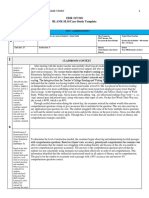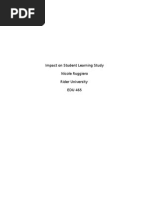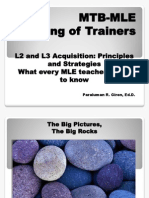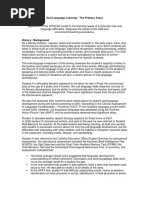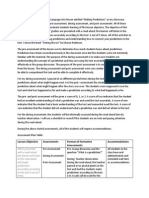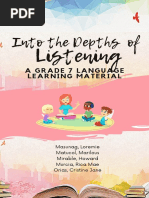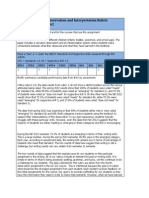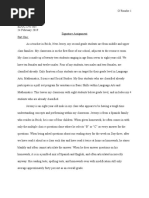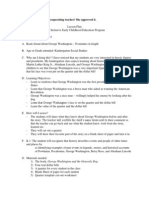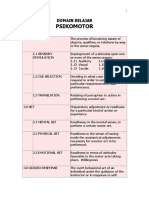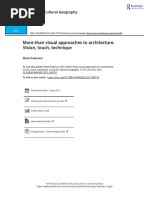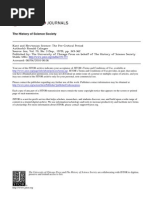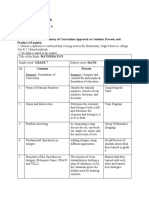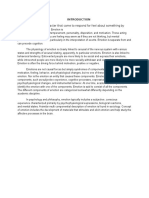Portfolio Nicks Mava Information
Portfolio Nicks Mava Information
Uploaded by
api-252458800Copyright:
Available Formats
Portfolio Nicks Mava Information
Portfolio Nicks Mava Information
Uploaded by
api-252458800Original Title
Copyright
Available Formats
Share this document
Did you find this document useful?
Is this content inappropriate?
Copyright:
Available Formats
Portfolio Nicks Mava Information
Portfolio Nicks Mava Information
Uploaded by
api-252458800Copyright:
Available Formats
MAVA: Montgomery Assessment of Vocabulary Acquisition
This assessment is for children aged 3 years, 0 months to 12 years, 11 months. The MAVA was designed to measure the development of childrens oral language by assessing listening, and speaking vocabulary. First because oral language precedes reading and writing, it serves as an excellent predictor of literacy skills. Second, the assessment informs teachers and specialists of the words or concepts that require extra attention in the classroom. Finally, the test guides special educators and parents toward appropriate intervention plans and IEP goals (Montgomery, 2008, p. 3). Its scope is expressive (speaking) and receptive (listening) vocabulary. The vocabulary words in the assessment fall into three tiers: Tier 1 Words:
Basic, high frequency words Nouns, verbs, adjectives Includes early reading words Examples: book, girl, sad, run, dog, and orange (Hutton, 2008) High frequency words across all domains Words with multiple meanings Tier 2 words are the most important words for direct instruction because they are good indicators of a students progress through school (Hutton, 2008). Examples: masterpiece, fortunate, industrious, measure, and benevolent (Hutton, 2008) Related to specific domains Subject area words Hobbies, technology, weather, professions Low frequency Examples: economics, isotope, asphalt, Revolutionary War, and crepe (Hutton, 2008)
Tier 2 Words:
Tier 3 Words:
Nicks completion of the MAVA: Nick was 6 years and 1 month of age when test was administered. He completed in the school library where it was quiet and the distractions were limited. Nick has an easy temperament and was very responsive during the assessment. He seemed to enjoy the assessment- smiled after he would answer the questions and would say things like, Im smart arent I? Scoring was easy, however Nick was very curious about what was being written down on the clipboard--he kept trying to see my clipboard when I was marking down his answers and he would ask, Did I get that right? after a lot of questions. I kept telling him he is doing great! I did the first part of the assessment, then took him back to class for snack, and then after snack, we went back and did
the second part. Next time I administer this assessment, I will do it all in one sitting so it is more accurate!!! Scores received: RECEPTIVE: Raw score: Standard Score: Confidence Interval: Percentile: Age Equivalent: EXPRESSIVE: Raw score: Standard Score: Confidence Interval: Percentile: Age Equivalent:
128 125 119-131 95 9;0
97 109 103-115 73 7;6
For receptive, he scored +1.5 standard deviations above the mean! For expressive, he scored roughly +.75 standard deviations above the mean! Response Analyzer I plugged in his incorrect answers into the response analyzer and this is the data I received:
Receptive vocabulary: Nick understands 100% of the words in Tier 1, 72% of the words in Tier 2, and 46% of the words in Tier 3 Expressive vocabulary: Nick understands 100% of the words in Tier 1, 50% of the words in Tier 2, and 9% of the words in Tier 3
Recommendations for facilitating Nicks learning: His Tier 1 words (early reading words, sight words, nouns, verbs, and adjectives) are very much used and understood. His Tier 2 words that play a large role in speaking and reading vocabulary need a little bit of work. Tier 2 words are the most important ones to directly teach to students because they are assumed to be known as students progress through school (Super Duper Publications, 2014). Examples of Tier 2 words include masterpiece, preference, fortuitous, glean, and measure and there are about 7,000 word families in English in Tier 2 (Super Duper Publications, 2014). Nick only knows a small percentage of expressive Tier 3 words, however he is above average and has the expressive vocabulary knowledge of a 7 and 6 months year old. The teacher should still attempt to enhance his vocabulary and begin to use bigger words with this student. Examples of Tier 3 words include things like ukulele, asphalt, genome, crepe, and cornice and they comprise the remaining 400,000 words in the US language fall in this tier.
Works Cited: Montgomery, J. K. (2008). MAVA: Montgomery assessment of vocabulary acquisition: Examiners manual. Greenville, South Carolina: Super Duper Publications. T.Hutton. (2008). Three tiers of vocabulary and education. [Blog comment]. Retrieved from http://blog.discoveryeducation.com/wpcontent/blogs.dir/1/files/2012/02/182_Vocabulary Tiers.pdf Super Duper Publications. (2014). Response Analyzers. Retrieved from http://www.superduperinc.com/Analyzer/Default.aspx
You might also like
- Task 3 Assessment CommentaryDocument8 pagesTask 3 Assessment Commentaryapi-30867799989% (9)
- Edtpa Early Childhood AssessmentcommentaryDocument5 pagesEdtpa Early Childhood Assessmentcommentaryapi-308678060100% (8)
- Case Application 2Document2 pagesCase Application 2Cesar Malenab67% (6)
- Task 3 Part D Assessment CommentaryDocument11 pagesTask 3 Part D Assessment Commentaryapi-309189621100% (2)
- Case Study An 317Document8 pagesCase Study An 317api-374526145No ratings yet
- Assessment CommentaryDocument7 pagesAssessment Commentaryapi-307652311No ratings yet
- Kristen Compton RDG 531 - Signature AssignmentDocument32 pagesKristen Compton RDG 531 - Signature Assignmentapi-229410703No ratings yet
- First Grade Readiness Checklist PortfolioDocument2 pagesFirst Grade Readiness Checklist Portfolioapi-252458800No ratings yet
- Irregular Verbs Lesson PlanDocument13 pagesIrregular Verbs Lesson Planapi-311868026100% (1)
- Sample Transdisciplinary Approach Lesson ExemplarDocument12 pagesSample Transdisciplinary Approach Lesson ExemplarR TECH100% (2)
- Portfolio Summary and Recommendations Lesson PlansDocument10 pagesPortfolio Summary and Recommendations Lesson Plansapi-252458800No ratings yet
- Impact On Student Learning StudyDocument39 pagesImpact On Student Learning Studyapi-248420848No ratings yet
- 670 Literacy Profile EpDocument4 pages670 Literacy Profile Epapi-738679864No ratings yet
- Action ResearchDocument10 pagesAction ResearchXyll Vyll100% (3)
- Diagnostic Spelling Test English RecordDocument3 pagesDiagnostic Spelling Test English RecordGFGC SirsiNo ratings yet
- DEPED 2012 - K TO 12 - L1-L2-L3-Dr. GironDocument56 pagesDEPED 2012 - K TO 12 - L1-L2-L3-Dr. Gironyachiru121No ratings yet
- Running Head: Analysis of Student Work - Asw 1Document19 pagesRunning Head: Analysis of Student Work - Asw 1api-447398273No ratings yet
- 2application CMitchellDocument22 pages2application CMitchellsubtitle kurdiNo ratings yet
- Action ResearchDocument11 pagesAction ResearchArbelle JaneeNo ratings yet
- Se 515 Assessment ReportDocument6 pagesSe 515 Assessment Reportapi-521673040No ratings yet
- RUNNING HEAD: Assessment Analysis and Next Instructional StepsDocument4 pagesRUNNING HEAD: Assessment Analysis and Next Instructional Stepsapi-367504817No ratings yet
- Assessment PlanDocument2 pagesAssessment Planapi-269835494No ratings yet
- Vercruyssen - Te 892 Fa20 Dual Learner Case Study Part 1Document7 pagesVercruyssen - Te 892 Fa20 Dual Learner Case Study Part 1api-532169738No ratings yet
- 2021NHT-EAL-exam-report 2Document6 pages2021NHT-EAL-exam-report 2ZOE ZHOUNo ratings yet
- Lacee EvaluationDocument4 pagesLacee Evaluationapi-313722056No ratings yet
- The Effects of The Davis Symbol Mastery System To Assist A Fourth Grader With Dyslexia in Spelling: A Case ReportDocument6 pagesThe Effects of The Davis Symbol Mastery System To Assist A Fourth Grader With Dyslexia in Spelling: A Case ReportYugo EltonNo ratings yet
- Dibels Assessment ProjectDocument32 pagesDibels Assessment Projectapi-472451946No ratings yet
- Assessments OverviewDocument6 pagesAssessments Overviewapi-254465169No ratings yet
- Dibels Assessment Paper FinalDocument15 pagesDibels Assessment Paper Finalapi-473349564No ratings yet
- After reading activities.Document5 pagesAfter reading activities.nopersonal1989No ratings yet
- Assessment B FinalDocument4 pagesAssessment B Finalshimaybombom64No ratings yet
- Capstone CompletedDocument34 pagesCapstone Completedapi-709207614No ratings yet
- Assessment Commentary STDocument7 pagesAssessment Commentary STapi-308137749No ratings yet
- Gr. 7 - Listening ComprehensionDocument44 pagesGr. 7 - Listening ComprehensionHoward Fallenorb BertillonNo ratings yet
- Building Vocabulary 2nd Grade - 201209291245095658Document67 pagesBuilding Vocabulary 2nd Grade - 201209291245095658Ruzica Milakovic StankovicNo ratings yet
- Noun FinalDocument3 pagesNoun Finalapi-350260783No ratings yet
- Fluency LP and Parent LetterDocument5 pagesFluency LP and Parent Letterapi-746634430No ratings yet
- Emergent Literacy Assessment - Report Reflection 1 1Document3 pagesEmergent Literacy Assessment - Report Reflection 1 1api-278539596No ratings yet
- After Reading CompleteDocument5 pagesAfter Reading Completenopersonal1989No ratings yet
- Assessment Report 2 EllisDocument6 pagesAssessment Report 2 Ellisapi-739078237No ratings yet
- Rachel Snyder Student Assessment Profiles - Amb CommentsDocument19 pagesRachel Snyder Student Assessment Profiles - Amb Commentsapi-250413843No ratings yet
- Aceact CommunicationDocument34 pagesAceact Communicationapi-305021928No ratings yet
- Formal Observation 1Document17 pagesFormal Observation 1api-450232271No ratings yet
- Apprtrackformsab 1Document2 pagesApprtrackformsab 1api-345766446No ratings yet
- Almond Gold Hatcher Literacy Profile - Partner Assignment Final Assessments and ReflectionDocument5 pagesAlmond Gold Hatcher Literacy Profile - Partner Assignment Final Assessments and Reflectionapi-742129295No ratings yet
- Curriculum Based AssessmentDocument20 pagesCurriculum Based Assessmentapi-335336043No ratings yet
- DLP With Indicators 2nd QuarterDocument3 pagesDLP With Indicators 2nd QuarterJaniceNo ratings yet
- Lesson Plan 4 GoodDocument4 pagesLesson Plan 4 Goodapi-205770029No ratings yet
- AssignmentDocument27 pagesAssignmentapi-263664713No ratings yet
- Word Study Lesson PlanDocument4 pagesWord Study Lesson Planapi-273380517No ratings yet
- USF Elementary Education Lesson Plan Template (S 2014) NameDocument7 pagesUSF Elementary Education Lesson Plan Template (S 2014) Nameapi-298252147No ratings yet
- Student Assessment Project FinalDocument16 pagesStudent Assessment Project Finalapi-458151012No ratings yet
- Assignment 5 - Affective and Psychomotor Instruments Marina Ferreira de Melo UW-Stout 2019 Professor Matthew SimoneauDocument9 pagesAssignment 5 - Affective and Psychomotor Instruments Marina Ferreira de Melo UW-Stout 2019 Professor Matthew SimoneauMarina KennedyNo ratings yet
- Student Assessment Project Final FinishedDocument15 pagesStudent Assessment Project Final Finishedapi-301858064No ratings yet
- Stead - Student Assessment ProjectDocument10 pagesStead - Student Assessment ProjectRaegan SteadNo ratings yet
- Phonics Ow Sound OuDocument7 pagesPhonics Ow Sound Ouapi-479420774No ratings yet
- The Learner's Developme NT and Environent: Field StudyDocument7 pagesThe Learner's Developme NT and Environent: Field Studyapi-311472011No ratings yet
- Action ResearchDocument16 pagesAction ResearchVanessajhoyelicotNo ratings yet
- EDRL442 Fall2012 Meghan Schaper AssessmentAnalysisDocument6 pagesEDRL442 Fall2012 Meghan Schaper AssessmentAnalysisMeghanNo ratings yet
- Listening and Speaking ActivitiesDocument41 pagesListening and Speaking Activitiesdaroksay50% (2)
- Key Assessment 1 Observation and Interpretation p56-62Document7 pagesKey Assessment 1 Observation and Interpretation p56-62api-215636357No ratings yet
- Signature AssignmentDocument11 pagesSignature Assignmentapi-437992597No ratings yet
- Diff Chart!Document2 pagesDiff Chart!api-252458800No ratings yet
- Word Study Lesson PlanDocument2 pagesWord Study Lesson Planapi-252458800100% (1)
- Read Aloud Lesson Plan ReflectionDocument9 pagesRead Aloud Lesson Plan Reflectionapi-252458800No ratings yet
- Books That Martha Reish Read To Us This Spring For PortfolioDocument1 pageBooks That Martha Reish Read To Us This Spring For Portfolioapi-252458800No ratings yet
- Field Study 5.Document46 pagesField Study 5.Julieann Salvacion Oberes100% (1)
- Domain Belajar PsikomotorDocument3 pagesDomain Belajar PsikomotorFhitriaNo ratings yet
- 3 Oral PresentationsDocument22 pages3 Oral PresentationsYN John100% (1)
- 6 Magicales FutureDocument3 pages6 Magicales FutureMaria IglesiasNo ratings yet
- Section 1 QNSDocument32 pagesSection 1 QNSKay HanNo ratings yet
- Japan2202 Weekly Schedule Week 1-2Document2 pagesJapan2202 Weekly Schedule Week 1-2DiaxxNo ratings yet
- ASPECT in SemanticsDocument17 pagesASPECT in SemanticsAlifa dina utami0% (1)
- APA OWL Sample Literature ReviewDocument9 pagesAPA OWL Sample Literature ReviewUddin NimatNo ratings yet
- 08t - Paterson2011 - More Than Visual Approaches To Architecture Vision Touch TechniqueDocument20 pages08t - Paterson2011 - More Than Visual Approaches To Architecture Vision Touch TechniqueFeridun CamryNo ratings yet
- Test Initial La Limba Engleza Pentru Clasa A IXDocument3 pagesTest Initial La Limba Engleza Pentru Clasa A IXValentinaNo ratings yet
- Objectives For FluencyDocument5 pagesObjectives For FluencyRommel StwokNo ratings yet
- Kant and Newtonian ScienceDocument16 pagesKant and Newtonian ScienceASFDPNo ratings yet
- Module 3 Educ15Document6 pagesModule 3 Educ15Racquel CalautitNo ratings yet
- Emotion (17th Nov)Document5 pagesEmotion (17th Nov)Deepanshi GuptaNo ratings yet
- Maed Final NotesDocument32 pagesMaed Final Notesmarnie godienesNo ratings yet
- Scopus - Sources - Linguistic Q2Document9 pagesScopus - Sources - Linguistic Q2noraNo ratings yet
- An Introduction To Deep Reinforcement Learning PDFDocument140 pagesAn Introduction To Deep Reinforcement Learning PDFtest accountNo ratings yet
- Investigating The Relationship Between Parental Involvement and Student Success in Educational InstitutionsDocument20 pagesInvestigating The Relationship Between Parental Involvement and Student Success in Educational InstitutionsLeonila AgustinNo ratings yet
- Factors Influencing Staff Motivation Among EmployeesDocument2 pagesFactors Influencing Staff Motivation Among Employeeszakaria1997No ratings yet
- PSY563Document1 pagePSY563Za-c Pelangi Senja100% (1)
- Pinto pm5 Inppt 06Document21 pagesPinto pm5 Inppt 06Gabriel KorleteyNo ratings yet
- Examenes Diagnosticos (Inglés)Document6 pagesExamenes Diagnosticos (Inglés)Maritza Pineda Flores100% (1)
- 16 Ways To Study For A Science Exam - WikihowDocument9 pages16 Ways To Study For A Science Exam - WikihowJasmin JoNo ratings yet
- FRACTIONSDocument3 pagesFRACTIONSROCHELL IPORONGNo ratings yet
- Ur, P. (N.D.) - Teaching Vocabulary. A Course in Language Teaching Trainee Book, 23-29.Document7 pagesUr, P. (N.D.) - Teaching Vocabulary. A Course in Language Teaching Trainee Book, 23-29.sigit raharjoNo ratings yet
- Practice Book - Grammar FocusedDocument101 pagesPractice Book - Grammar FocusedJulie NguyenNo ratings yet
- Answering Questions in PMR English PaperDocument11 pagesAnswering Questions in PMR English PaperMahani Abu TalibNo ratings yet




